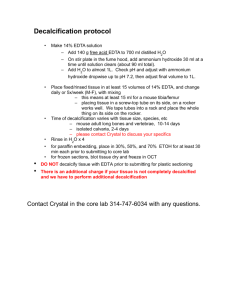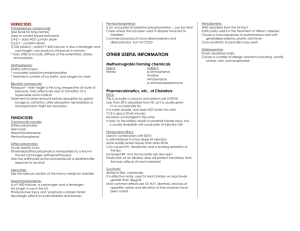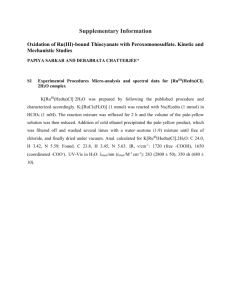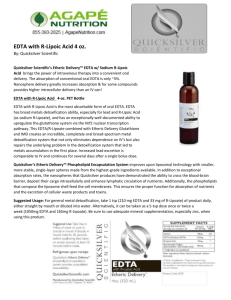MEDICARDIUM OR EDTA SUPPOSITORIES FOR DETOXING
advertisement
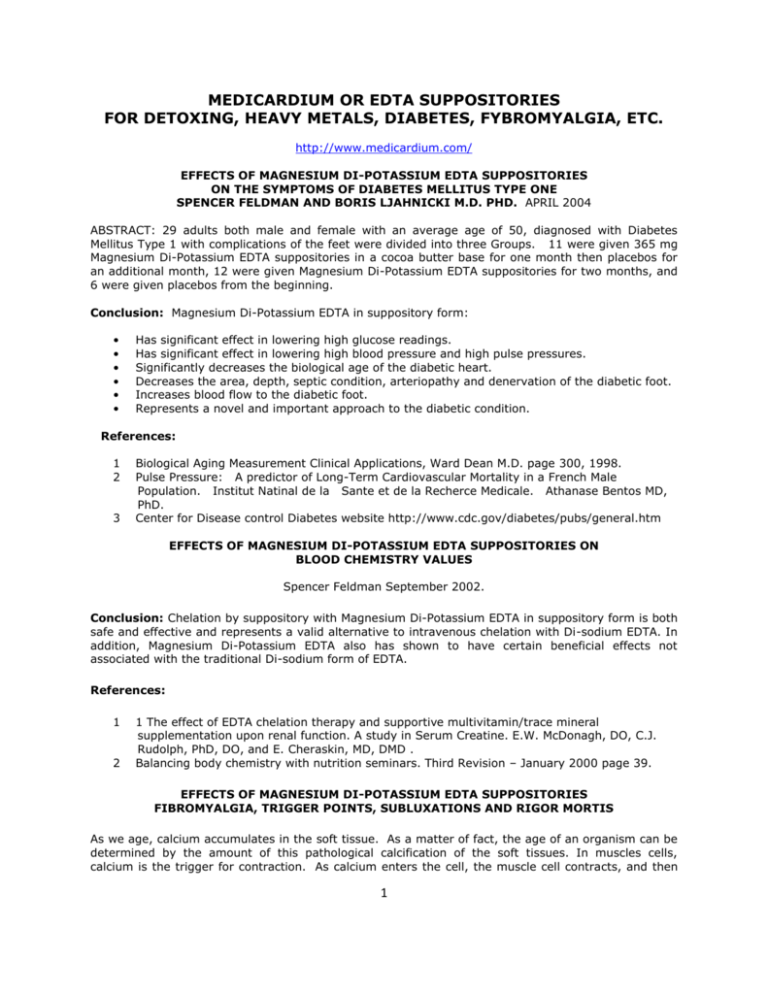
MEDICARDIUM OR EDTA SUPPOSITORIES FOR DETOXING, HEAVY METALS, DIABETES, FYBROMYALGIA, ETC. http://www.medicardium.com/ EFFECTS OF MAGNESIUM DI-POTASSIUM EDTA SUPPOSITORIES ON THE SYMPTOMS OF DIABETES MELLITUS TYPE ONE SPENCER FELDMAN AND BORIS LJAHNICKI M.D. PHD. APRIL 2004 ABSTRACT: 29 adults both male and female with an average age of 50, diagnosed with Diabetes Mellitus Type 1 with complications of the feet were divided into three Groups. 11 were given 365 mg Magnesium Di-Potassium EDTA suppositories in a cocoa butter base for one month then placebos for an additional month, 12 were given Magnesium Di-Potassium EDTA suppositories for two months, and 6 were given placebos from the beginning. Conclusion: Magnesium Di-Potassium EDTA in suppository form: • • • • • • Has significant effect in lowering high glucose readings. Has significant effect in lowering high blood pressure and high pulse pressures. Significantly decreases the biological age of the diabetic heart. Decreases the area, depth, septic condition, arteriopathy and denervation of the diabetic foot. Increases blood flow to the diabetic foot. Represents a novel and important approach to the diabetic condition. References: 1 2 3 Biological Aging Measurement Clinical Applications, Ward Dean M.D. page 300, 1998. Pulse Pressure: A predictor of Long-Term Cardiovascular Mortality in a French Male Population. Institut Natinal de la Sante et de la Recherce Medicale. Athanase Bentos MD, PhD. Center for Disease control Diabetes website http://www.cdc.gov/diabetes/pubs/general.htm EFFECTS OF MAGNESIUM DI-POTASSIUM EDTA SUPPOSITORIES ON BLOOD CHEMISTRY VALUES Spencer Feldman September 2002. Conclusion: Chelation by suppository with Magnesium Di-Potassium EDTA in suppository form is both safe and effective and represents a valid alternative to intravenous chelation with Di-sodium EDTA. In addition, Magnesium Di-Potassium EDTA also has shown to have certain beneficial effects not associated with the traditional Di-sodium form of EDTA. References: 1 2 1 The effect of EDTA chelation therapy and supportive multivitamin/trace mineral supplementation upon renal function. A study in Serum Creatine. E.W. McDonagh, DO, C.J. Rudolph, PhD, DO, and E. Cheraskin, MD, DMD . Balancing body chemistry with nutrition seminars. Third Revision – January 2000 page 39. EFFECTS OF MAGNESIUM DI-POTASSIUM EDTA SUPPOSITORIES FIBROMYALGIA, TRIGGER POINTS, SUBLUXATIONS AND RIGOR MORTIS As we age, calcium accumulates in the soft tissue. As a matter of fact, the age of an organism can be determined by the amount of this pathological calcification of the soft tissues. In muscles cells, calcium is the trigger for contraction. As calcium enters the cell, the muscle cell contracts, and then 1 as it is pumped out again, the muscle relaxes. If the pathological calcium in a cell reaches a certain point, and the cell is no longer able to remove it, then the muscle cell will stay in a contracted position indefinitely. This is the definition of a trigger point, a pathologically contracted group of muscle cells that cannot release. As we age, our muscles become tighter and tighter with more trigger points becoming evident. These trigger points can also pull the vertebra out of alignment causing subluxations and compression of the spinal nerves. Fibromyalgia is the pathological accumulation of trigger points in a person whose age does not justify the calcification. Rigor mortis is the ultimate expression of this muscle contraction. As all ATP production stops in the cells at death, calcium floods into all the muscle cells and causes global contractions. Various mechanisms of how this happens have been proposed. Some claim that the kidney's inability to effectively remove phosphorous from the bloodstream results in a accumulation of acidic phosphorous in the cells. The body then imports calcium into the cell to maintain a proper ph. The beneficial results with Guanifenesin support this claim. Some suggest that magnesium deficiency lowers ATP production so that the cells cannot rid themselves of the calcium that naturally enters the cell due to concentration gradients (1:10,000) Others suggest infections as a cause. Certain infections cause hypercoagulation which decreases local circulation, thereby lowering local oxygen levels. Lower oxygen levels decreases ATP production and ATP is required to operate the pumps which keep calcium from accumulating in the cell. Regardless of the initial cause of Fibromyalgia, the calcium must be removed to effect a recovery. For this reason, EDTA chelation is an option since it is able to chelate pathological calcium out of the body. The 3 potential causes of Fibromyalgia may also be addressed with chelation 1) Phosphorous accumulation due to kidney insufficiency: EDTA chelation has been shown to have a normalizing effect on kidney function bringing low creatine levels up and high creatine levels down. This information can be found in the following study: "The effect of EDTA chelation plus supportive multivitamin/trace mineral supplementation upon renal function. A study in serum creatine. E. W. McDonagh, D.O." Also, the increase of metabolic potassium in magnesium di-potassium EDTA helps displace cellular phosphorous. 2) Low ATP production due to low magnesium levels: Magnesium is a difficult mineral to absorb and not commonly found in adequate amounts in the standard American diet. If magnesium based EDTA is used, then magnesium levels can be restored. 3) Hypercoagulation due to infection: Chelation is known to reduce hypercoagulation due to its stimulating effects on prostacyclin and it's inhibitory effects on thromboxane (the hormones which control the blood clotting cascade). Thus magnesium based chelation not only addresses the manifestations of fibromyalgia (the calcifications) but also the potential causes of it. Magnesium based chelation can also aid with circulation problems, but it also eliminates accumulations of heavy metal poisons in the body: CIRCULATION: Every day your heart pumps 1,900 gallons of blood through the 100,000 miles of living pipes that make up your circulatory system … Toxins, infections, stress, poor diet and the effects of aging cause the arteries to become brittle and filled with plaque, and blood to thicken and become harder to move. If you are suffering from circulatory disturbances or simply want to increase and maintain your vitality, then ask your doctor if chelation is right for you. 2 MERCURY: Each silver filling releases up to 17 mcg of mercury every day. This increases to 500 mcg when the smoking of cigarettes, the drinking of hot liquids, gum chewing, acidic saliva or the grinding of teeth at night. Mercury accumulates in the brain, heart, kidneys and endocrine glands and can cause depression, auto-immune diseases, memory loss, tremors, anemia and heart attack. ALUMINUM can be found in drinking water, anti-perspirants, baking powders, feminine hygiene products, cow and soy milk, baby formula, antacids, and of course aluminum foil, pots and pans. It accumulates in the skin, bones, brain and kidneys and can cause Alzheimer's and Parkinson’s disease. LEAD is found in cosmetics, plastics, batteries, gasoline, insecticides, pottery glaze, soldered pipes, and paint. Lead accumulates in the brain, liver, kidneys and bones. For each 30 mcg of lead in a child's blood, his or her IQ drops 10 points. BARIUM compounds are found in soaps, ceramics, paper, glass, plastics, textiles, dyes, fuel additives, rubber, paint and pesticides. Barium toxicity can cause vomiting, diarrhea, and abdominal pain. NICKLE is found in stainless steel cutlery, pots and pans, coins, dental fillings and batteries. It accumulates in the bones, kidneys, liver, lungs, immune system and the brain, where it can cause genetic damage and cancer. ARSENIC is found in cigarette smoke, laundry detergents, beer, seafood and drinking water, It can cause headaches, confusion and sleepiness. It can damage the kidneys, liver, and lungs. CADMIUM: Exposure to cadmium happens mostly in the workplace where cadmium products are made. The general population is exposed from breathing cigarette smoke or eating cadmium contaminated foods. Cadmium damages the lungs, can cause kidney disease, and may irritate the digestive tract. This substance has been found in at least 776 of the 1,467 National Priorities List sites identified by the Environmental Protection Agency (EPA). URANIUM is a radioactive element that disintegrates eventually into lead. There has been over 2,000 nuclear detonations on our planet since Hiroshima casting uranium into our atmosphere, not counting events like Three Mile Island and Chernobyl. Radioactive materials can cause cancer and birth defects. EDTA has been scientifically proven to bind to and remove heavy metals from the body. GUIDELINES FOR TAKING MEDICARDIUM Protocol 1: If the client is in good health currently, he or she can take one suppository every third day, (one box a month). Protocol 2: If the client needs to resolve an immediate crisis (diabetic leg ulcers) or is in pain (fibromyalgia) you may wish to have them take the product every day for a period of time. This will accelerate the effect. When the immediate situation resolves, the client can go to ‘protocol one’ for maintenance. Protocol 3: If the client is in immediate life threatening danger (impending coronary) or is about to lose a limb( diabetic complications) you may wish to use the product as often as twice or three times a day for a few days. EDTA AND TREATMENT OF AUTISM, LUPUS, LYME DISEASE AND MULTIPLE SCLEROSIS 3 In the following article, Dr. Peta Cohen uses a combination of Enzymes (nattokinase and lumbrokinase); EDTA; antimicrobials (i.e. grapefruit seed extract, or GSE; echinacea, goldenseal, gentian, tea tree oil, oregano oil, neem); binders (citrus pectin, aluminum free sodium bicarbonate); and buffering agents (i.e. Vitamin C) to successfully treat autism. He believes this therapy can be used successfully to treat lyme disease, lupus and multiple sclerosis. DISSOLVE BIOFILMS WITH FIBRINOLYTIC ENZYMES: A NOVEL APPROACH TO CHRONIC INFECTION IN AUTISM SPECTRUM DISORDERS 2009 Allergy Research Group An Interview with Peta Cohen, M.S., R.D., founder of Total Life Center in Northern New Jersey. Cohen specializes in treating children with autism using a biomedical / nutritional model. Cohen received her Masters in Clinical Nutrition from New York University and has been a Defeat Autism Now! practitioner for the past ten years. Focus: You have evolved a highly successful strategy to treating chronic bacterial infections and biofilms that involves some new insights and relies in part on fibrinolytic enzymes like nattokinase and lumbrokinase. I understand you are working with autism experts like Anjum Usman, M.D. and functional medicine pioneers to get the word out on your new insights. Cohen: Bacteria build biofilms by first aggregating together, and then rapidly weaving this protective web or matrix around them. They build a polymeric matrix ... They’re very protected. They’re very crafty in creating a way to survive and procreate and hide from the immune system. Focus: Why are they protected, and how does that impact our health? Cohen: They’re protected because they’ve built this matrix but are still alive, still fermenting and metabolizing and leaching toxins into the bloodstream …Because of the biofilm they can no longer be reached by an anti-infectious agent or even the immune system. And because of the biofilm you may not find evidence of the infection in the fecal matter when you do stool cultures. For years, I knew from organic acid testing, from the short-chain fatty acids and metabolites the children were excreting, that they carried these infections. Yet when I did a stool culture I did not find the bugs. Focus: When you began to work at dissolving the biofilms, did you find the bugs? Cohen: Oh yes! But I found something else that was just as fascinating, something nobody was thinking about … It’s standard knowledge that biofilm bacteria sequester calcium, magnesium and iron to help build that matrix. Minerals give the biofilm integrity—as if you’re building a wall … To address this, first you use fibrinolytics to help dissolve the fibrin, then you use EDTA to chelate out the minerals. And guess what? We started getting huge dumps of toxic metal. Now why is that? I think the answer points to something so huge, whether we’re dealing with autism or lyme disease or multiple sclerosis or lupus or even cancer. Focus: Why were the kids dumping toxic metals when you began to degrade the biofilms? Cohen: EDTA is able to chelate them well. Mercury, and copper, and other heavy metals are positively charged. Why would the bug preferentially insert calcium or magnesium? It could use any positively charged metal. As we degraded this biofilm matrix and liberated these bugs, not only did the organic acid levels get higher … but the kids started to dump metals into the bowel. I felt like I’d exposed these little terrorists in a cell. Focus: So the metals and the bugs are both in the gut? Cohen: Right. At an Autism One Conference in Chicago last May, one researcher presented his proton analysis of brain tissue, attempting to verify the presence of mercury in the brains of autistic children, and he couldn’t find it. Yet he still found evidence of activation of the microglia (a type of glial cell that acts as the first and main form of active immune defense in the central nervous system) as a consequence of toxic metals. So where are these metals? I’m suggesting they are in the biofilm, along 4 with the bugs, in the gut. If the biofilm wasn’t using toxic metals, along with common minerals, to build the biofilm, then why all of a sudden do I get these huge dumps of metals on stool tests? Focus: What exactly is your therapy and what sequence do you use? Cohen: I start with enzymes like nattokinase and lumbrokinase, as well as other mucolytic enzymes, to get the best, broad fibrinolytic effect. Dr. Usman feels nattokinase is particularly good at degrading strep biofilms and I think that strep is a very big player in these childrens’ health. I will run strep titers and they will be extraordinarily high. And these children—and certainly some adults as well—will manifest strep as a comorbid infection that has significant implications for neurological function. They will have very OCD type tendencies, and sometimes almost psychotic outbursts. Focus: How much do you recommend? Cohen: Remember, these patients are very young; some are just a few years old. So I will recommend half a capsule of each, two times a day. That would be a 50 milligram capsule of nattokinase, and a 20 milligram capsule of lumbrokinase. First do the enzymes along with EDTA, then thirty minutes later, add in an arsenal of antimicrobials. I use formulations containing berberine, artemisinin, citrus seed extract, black walnut hulls, artemisia herb, echinacea, goldenseal, gentian, tea tree oil, fumitory, gentian, galbanum oil, oregano oil, neem, and pharmaceuticals as well when necessary, such as Vancomycin, Diflucan, Gentamycin. I use a different one every day. Then an hour later you come in with the binders to help mop up the debris. I use chitosan, citrus pectin, a special bicarbonate formula, organic germanium, chlorella and others. I also use buffering agents, such as buffered vitamin C, since when the body is destroying bacteria it becomes acidic. Minerals must be assessed, and repleted when necessary. I test bloodwork and “pees and poos” (urine and stool) every two months to monitor the process. Focus: Enzymes, EDTA, antimicrobials, binders, and buffering agents. What are the clinical results? Cohen: They’re fantastic. It’s like the missing piece. I had one little autistic boy who lives in the city who is loaded with viruses and infections and is now almost fully recovered. His mother used to complain about the terribly high levels of copper in his bloodstream and that his hair was like a copper mattress. We measured the hair but there was a marginal amount of copper in it. He was not eliminating. As we got into the thick of the biofilms his copper blew out of his body in his stool, for months and months. He’d been loaded with copper. I’ve had other children struggling for ages to get mercury out, and out it came. Focus: It sounds like this approach would work for any chronic illness in which chronic infection plays a role. Cohen: Yes, I think biofilms are a huge missing piece in Lupus, Lyme Disease, Multiple Sclerosis and any autoimmune-type chronic infection. You have to ask, what compels the immune system to maintain this state of dysfunction? Ask yourself, how could an organism perceived by the immune system as foreign survive its presence? Either something has corrupted the immune system, or the organism has transformed itself in a way that the immune system can’t find it. That’s what the biofilm does. I believe it’s one of the biggest medical issues we’re dealing with today. —— Abstracts —— J Dermatol Sci. 1997 Nov;16(1):2-10 Biofilm formation of Staphylococcus aureus strains isolated from impetigo and furuncle: role of fibrinogen and fibrin. Akiyama H, Ueda M, Kanzaki H, Tada J, Arata J. Appl Environ Microbiol. 2008 Aug;74 Fibrinogen induces biofilm formation by Streptococcus suis and enhances its antibiotic resistance. Grignon L, Grenier D. 5



